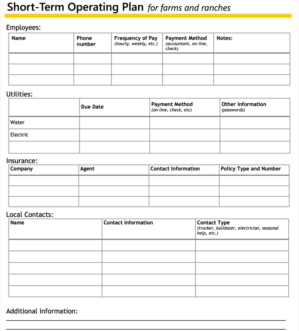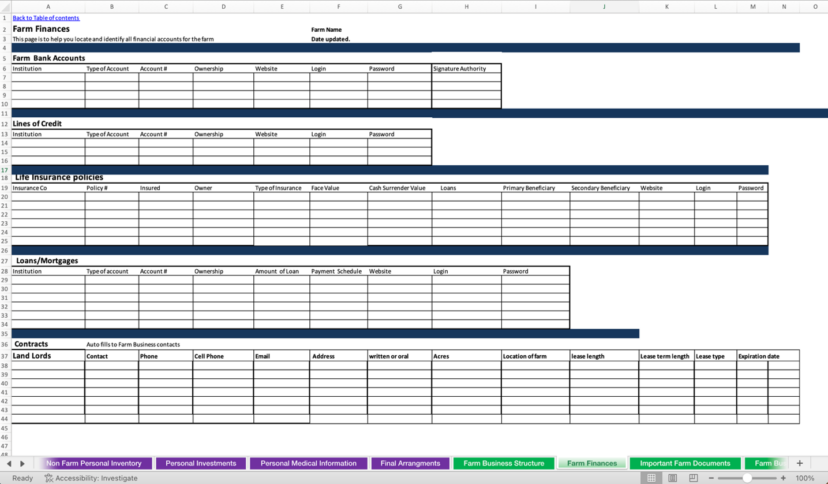This article helps a farm business think through contingency scenarios in case a key member of the farm is absent. The discussion and resources can benefit anyone stepping into new responsibilities or temporarily needing solutions to keep the farm operational. The goal is that were something to occur, the farm can handle the interruption as smoothly and efficiently as possible.
Operational Plans
In agriculture, there are inherent risks. The United States Department of Agriculture (USDA) categorizes them into five categories: production, market, financial, institutional, and human risk. Human or personal risk refers to factors such as problems with human health or personal relationships that can affect the farm business. Accidents, illness, death, and divorce are examples of personal crises that can threaten a farm business.1
A farm manager wears many hats and deals with various businesses and tasks in running a farm. Sometimes there is one farm manager, other times, there are multiple. Estate planning and succession, an important topic, relates to the long-term plans of the farm.2 Short-term scenarios happen when a manager or key employee is away because of personal matters, sickness, vacation, or an unexpected death. These situations occur, and while the event itself is stressful, even more so when business and farm obligations start to pile up. Committing to short-term operation planning can help farm members combat this scenario.
Even if there is a succession plan to transfer the farm, day-to-day activities are still necessary to keep the farm operating. Not all situations are immediate or dire, but if a family member needs access to a website or account, not having the login could be an annoyance or a severe hindrance at worst. A complete list in one place provides critical help to anyone having to step into a new role.
Several publications are mentioned that are available for use. Consider them prompts and outlines to think through what is needed. The best operational plan is tailored to you and your operation. Your family, local Clemson Extension agent, and other trusted confidants can be a sounding board to help you develop the plan. You can find contact information for your local Clemson Extension agent on the county offices website (clemson.edu/extension/co). Once your plan is complete, make copies and clearly communicate where the plan is located and how to access it. A plan will detail accounts, contacts, obligations, and critical information used for managing the farm.
Examples of information that may be included in a plan:
- Tracts of land with corresponding surveys or maps of the property
- Livestock feed/availability, veterinarians, and grazing plans for cattle
- Location of keys and business documents
- Contact information for important advisors to the farm
Two examples of document plans are included below (figures 1 and 2).

Figure 2. University of Missouri Extension Short-Term Operating Plan. Image credit: screenshot by author.
Points to Consider
Information related to the farm can frequently change. So, while a plan may be written early this year, by next year, the information could be out of date. Business information is already being reviewed when filing annual taxes, so it may be an excellent opportunity to evaluate the plan. Having wrong or outdated information could be as detrimental as having no information at all.
Some information, such as bank accounts, passwords, and other confidential data, can be highly sensitive. Some people are okay with having this information online, and others are not. Either way, this information is critical to communicate because a family member trying to figure out passwords, resetting accounts, or being locked out entirely could be a long, frustrating process. Information can be listed online and offline based on the comfort level of the parties involved.
Having multiple copies of the plan is advised, and sharing copies with relevant personnel will ensure one is available if needed. Depending on your relationship with your banker, lawyer, neighbor, etc., these may be individuals you share the plan with as well.
Resources
- Short-Term Operating Plan for Farms and Ranches
Worksheet to document important aspects of the business - AgPlan (agplan.umn.edu) is a business planning website offered by the Center for Farm Financial Management. It is free to use AgPlan, but registration is required, and once logged in, select “Short-Term Operating Plan”.
- Code Red “Contingency Planning for Your Family and Farm Operation” is a Microsoft Excel workbook that can be printed, shared virtually, or saved on USB drives.
Conclusion
This discussion of short-term planning is part of a more extensive discussion of operational risk and transition planning. Having a strategy to transfer relationships and responsibilities according to an owner’s wishes should not be ignored. Succession planning resources are available on the Clemson Cooperative Extension Agribusiness website (clemson.edu/extension/agribusiness/resources/farm-transition.html). Farm owners and managers are encouraged to reach out to trusted advisors when making important decisions regarding the farm. Farms are a critical part of the state and the economy; adequate short and long-term planning can help sustain them into the future.
References Cited
- USDA. Risk Management: Risk in Agriculture. Washington (DC): US Department of Agriculture, Economic Research Service; 2023 [accessed 2023 Feb 28]. https://www.ers.usda.gov/topics/farm-practices-management/risk-management/risk-in-agriculture.
- National Agricultural Law Center. Estate Planning and Taxation. Fayetteville (AZ): University of Arkansas, National Agricultural Law Center; 2022 [accessed 2023 Mar 14]. https://nationalaglawcenter.org/research-by-topic/estate-planning-and-taxation/


